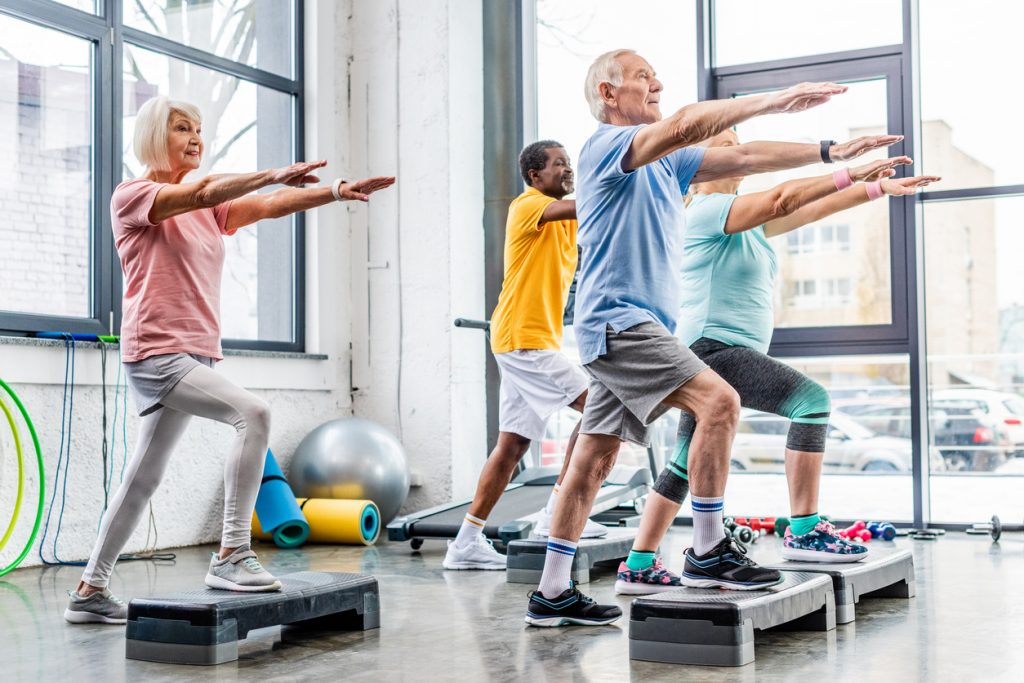Budget Workouts and Everyday Habits for Senior Fitness

Life with chronic pain can be extremely challenging. Whether your healthcare provider has prescribed medication, suggested acupuncture, recommended surgery, or explored other treatment options, you should establish healthy senior fitness habits to try to manage (or at least not trigger) your pain and keep yourself as healthy as possible.
The Importance of Exercise for Senior Fitness and Wellness
No matter your age, senior fitness is important for your overall health and wellness. According to the Mayo Clinic, regular exercise helps prevent or manage numerous health issues, including
- Diabetes
- Heart disease
- High blood pressure
- Several types of cancer
It can also help reduce stress, anxiety, and depression as well. For older adults, physical activity can be particularly beneficial because it increases strength, balance, and flexibility, and thus reduces the risk of falls, which are considered a leading cause of death in seniors.
If you have chronic pain, talk to your physical therapist or doctor. Discuss the types of exercises may be ideal for your condition. For example, stretching and yoga can increase flexibility and loosen muscles, which can, in turn, reduce pain. Studies also have shown that brisk walking is beneficial for weight management, heart health, and also chronic pain.
Tips for Working Out at the Gym
For older adults, the cost of a gym membership can be a burden. Fortunately, many seniors have access to the SilverSneakers program, a free fitness membership offered through many Medicare Advantage and Medigap plans. With 14,000 fitness locations around the country, you may have access right around the corner. Take a look at your current healthcare coverage to see if you’re eligible. If you’re not, consider changing your coverage during this year’s annual election period.
Tips for Exercising at Home
If you prefer to work out at home, you can set up a workout space. Be sure to include affordable, reliable gear and equipment to help you meet your senior fitness goals. If you need to buy equipment like free weights, a stationary bike, or a treadmill, turn to retailers like BestBuy. Search online for coupons, a BestBuy promo code, and cash back offers to help you get everything you need and stay within budget.
Getting the Proper Amount of Sleep
One of the most important things you can do for your overall health is to get enough quality sleep. Most adults require 7 to 9 hours each night. Lack of sleep can cause irritability, fatigue, and cognitive issues. Studies have shown that long-term sleep deprivation can lead to health problems including weakened immunity, as well as an increased risk of:
- Anxiety
- Depression
- Heart disease
- Inflammation
- Obesity
- Other conditions
Sleep apnea, chronic pain, frequent urination, and other age-related problems can cause older adults to have trouble falling asleep, sleeping deeply, and staying asleep. Avoid alcohol, caffeine, and electronics in the evening hours. Talk to your healthcare provider about possible strategies and treatments to improve your sleep quality.
Eating a Balanced Diet
According to the Academy of Nutrition and Dietetics, a healthy diet is one that is rich in fruits and vegetables, whole grains, low-fat dairy products and various types of protein and healthy fats found in lean meats fish, beans and nuts. Additionally, a healthy eating plan should limit saturated fats, trans fats, salt, and added sugar to a minimum.
For older adults, nutrients like calcium and vitamin D are important for bone health, B12 for energy levels, and omega-3 fatty acids for inflammation and immunity. Talk to your healthcare providers about any specific dietary needs based on your current health status.
Final Points
Chronic pain makes otherwise routine aspects of everyday life more difficult and more time-consuming. You can take steps to overcome the challenges without draining your bank account. You can’t be assured of a long life.
But, you can manage pain and lower your risk of a number of diseases by establishing a health plan that includes good senior fitness habits such as exercising regularly, sleeping properly, and eating well.
This article was written by personal trainer Jason Lewis. Find more of his work at strongwell.com.
5 Healthy Aging Tips to Help You Make The Most of Your Senior Years

When you’re a senior looking to improve your quality of life, there’s no better solution than improving your physical and mental health. Health and wellness influences all other aspects of life, which is why finding easy ways to boost yours is the key to being happier in retirement. This solution can be fairly simple if you know the right steps to take. So, keep reading our healthy aging tips for some insights into sustaining a healthy quality of life and increasing your happiness as a senior.
1. Be Sure to Schedule Regular Wellness Exams
Preventative care is one of the best ways you can stay in control of your quality of life as you age. If you haven’t already, make an appointment for a wellness exam with your preferred healthcare provider.
Seniors who are on Medicare can use their annual wellness visit to head off potentially serious health conditions before they get worse, as well as obtain professional advice as to any diet, lifestyle, or wellness changes that can be made to improve overall physical and mental health. This is also a good time to set up a schedule for future wellness visits.
2. Take Steps to Relieve or Reduce Chronic Pain
If you are living with chronic pain, you may also be living with a lower quality of life. Pain can impact so many different aspects of your well-being aside from physical comfort; your mental health, relationships, and overall outlook on life can all be severely affected by pain.
So, look for help with pain conditions, such as these resources from Comprehensive Pain Management Center, if you really want to take back control of your health and happiness. Certain conditions require different approaches to relieve pain, so make sure you drill down into these resources to find the perfect pain management solution for you.
3. Eat Foods That Will Preserve Your Quality of Life
These healthy aging tips include self-care when it comes to meals. You can definitely ask your doctor for diet tips during your annual wellness exam, but it also helps to have some food knowledge of your own. You may find that following certain top diets, such as the DASH or Mediterranean diet, helps you:
- Maintain a healthy weight
- Manage brain function
- Improves your odds of living a long, healthy life
That’s because these diets are heavy on whole foods that benefit your brain and body while being light on foods that hinder your health, such as red meats and processed foods. Check with your doctor before following these meals plans, and remember to make changes slowly to help them stick.
4. Make Regular Physical Activity a Major Priority
One of the lifestyles changes your doctor will likely suggest is regular physical exercise. For seniors, staying active is important for a variety of reasons. You can maintain more muscle mass if you work strength training into your routine, while cardio can help you maintain better mental health.
If you suffer from chronic pain, exercises such as swimming can provide relief from your symptoms as well. Aim to add these exercises to your routine a few times a week and you will begin to see improvements to your physical and mental health.
5. Address Any Habits or Health Issues Affecting Sleep
When thinking about healthy aging tips, there is one that is the most important.
One aspect that impacts overall quality of life, health, and pain management is sleep. Poor sleep quality can increase your risk for serious diseases, including Alzheimer’s, and can also lead to worsened mental health issues.
When you live with chronic pain, not getting enough sleep can also have negative impacts, such as making pain symptoms worse by altering the way your brain responds to pain. So, how can you make sure you’re getting the sleep you need to age well? Your nighttime habits can have the biggest effect on your quality of sleep, so make sure you are relaxing enough before bed and try to avoid screens several hours before.
Conclusion
Quality of life is important at any age, but it is especially important for seniors. So, improve yours by taking more control over your mind and body with these healthy aging tips. Incorporate the habits that will keep you healthy, and take the necessary steps that will keep you happy as well. Because, contrary to popular belief, the years ahead of you really can be the best yet.
This article was written by personal trainer Jason Lewis. Find more of his work at strongwell.com
Aging In Place Is A Realistic Option In Spite Of Mobility Issues

Growing older can mean an increasing loss of mobility for many people. As age and health conditions causing chronic pain take their toll, getting around, even at home, can become challenging.
Eventually, that can make certain life decisions necessary for the sake of health and safety.
Thankfully, there are ways to modify residences which allow seniors to age in the comforts of home.
Aging in place.
North Americans are growing older.
The number of seniors in Canada is projected to more than double by 2036, reaching 9.8 million, and seniors in the U.S. are projected to reach 98 million by 2060.
A significant portion of older adults suffer with health concerns such as arthritis that cause chronic pain and reduce mobility.
Thanks to design concepts oriented toward “aging in place,” more seniors than ever before are able to grow older and remain independent in their own homes, in spite of mobility loss.
To age in place, seniors can modify their homes for better accessibility, and more new homes are being built with aging in place in mind than ever before.
Many people assume accessible changes will feel institutional. However thanks to the popularity of aging in place, some experts point out modifications can be comfortable and attractive.
Easy modifications.
Many of the home modifications helpful to seniors are simple and inexpensive, yet they go a long way toward eliminating risk of injury.
For instance, SFGate suggests installing supportive handrails on both sides of indoor and outdoor stairwells.
Eliminating slipping and tripping hazards such as ottomans and piles of magazines can make a big difference in increasing safety in the home.
Adding nonslip tape strips to stair steps and shower and bath areas can also help seniors avoid accidents, and shower and bath safety can be improved with a seat in the shower stall, a handheld spray nozzle for seated washing, and the installation of grab bars.
Simply improving visibility in the home can be a boon.
Consider reflective tape on changes in step heights, increasing natural daylight with sheer curtains, and adding nightlights in commonly traveled dim areas, such as the bedroom, hallway, and bathroom.
Installing brighter light bulbs can also help, and adding under-cabinet task lighting in the kitchen can make food preparation easier.
Exchanging traditional light switches for motion-activated light switches or even rocker switches can help as well.
Other easy modifications include such things as lever-style door handles and faucet handles, non-scald devices on water faucets, and garage door openers.
More advanced changes.
Depending on the situation, many seniors opt for more advanced home modifications.
Homes with steps to the entrance can be re-graded, or a ramp can be installed for safer and easier movement from the car and into the home.
Doorways can be widened for easier accommodation of assistive devices, light switches can be lowered, and outlets can be raised to be reached more easily.
Some seniors benefit from push-button appliances.
A fully accessible walk-in shower can help avoid slips and can make transitioning in the bathroom easier.
Some professionals suggest an open floor plan and easy-care landscaping. And as Huffington Post notes, ideally seniors should enjoy one-floor living spaces.
This can mean turning a home office into a master suite, or moving laundry facilities from the basement to the kitchen, bathroom, or bedroom area.
Moving ideas.
Sometimes modifying a home isn’t a practical solution.
Many seniors prefer not to live with the mess of remodeling or the hassles of arranging for contractors.
Thankfully, accessible homes are increasingly available.
Seniors can use online filters to search for accessible homes for sale in desired areas.
For example, you can find accessible homes in Thousand Oaks, CA, with a median listing price of $900K. Using an aging-in-place accessibility checklist helps seniors find the right home to meet their needs.
Chronic pain and loss of mobility due to age and health conditions such as arthritis don’t mean seniors need to give up their independence.
Homes can be modified to accommodate their needs.
Thanks to aging-in-place design, older adults can safely remain in their homes.
This is a guest blog post written by Kent Elliot, author of “Aging in Place One Project at a Time: DIY Home Modifications That Don’t Require a Professional“. You can find his book here.
How to Stay Optimistic with Chronic Illness

Chronic illness is a fact of life for about half of American adults, a statistic that has been steadily and tragically growing over the past few decades. It isn’t just poor health and trouble coping with any number of crippling symptoms. It’s also a deep mental anguish that too often transforms from a feeling to a disorder.
Illness and pain come in many shapes and sizes. Some are far more common than others, such as type-I diabetes and arthritis. Others are less common, such as inflammatory bowel diseases or chronic fatigue syndrome. Yet they all share the fact that they’re debilitating, to the point where leading a life of optimism with such a diagnosis shackled to one’s legs can seem like a pipedream.
Yet many make it happen anyway. Not out of sheer bullheadedness, but out of a love for life perpetuated through gratitude and unhindered by bouts of pain and struggle. It’s not just possible to stay optimistic and happy while struggling with a chronic illness – it is necessary if you want to successfully live with the diagnosis.
Acknowledging the Pain of Chronic Illness
We’re not here to make light of anybody’s situation when we say that it’s important to look on the bright side of things when struggling with a chronic illness. We know exactly how terrible they can be, and just how much life and happiness they soak up and raze to the ground.
The definition of a chronic illness is that it is a long-term disease that can last years or even indefinitely, and progressively become harder to combat. These diseases often leave people with disabilities, or secondary conditions including chronic pain. For those who are diagnosed with one, living with it will be their greatest challenge. Like great big wall, it can encompass your entire field of vision. It can hog every detail of your life, and separate you from what could be a great life.
Not all chronic illnesses start out with the same severity, or share that severity from case to case. However, their progressive nature and tendency to last for years or even decades means anyone struck with the diagnosis of a chronic illness will be struggling immensely. Yet in every case, optimism plays a vital role.
Why Optimism Makes a Difference
Chronic illnesses aren’t just a simple diagnosis, like many other diseases. They are notorious for the fact that they’re hard to treat, and can sometimes be untreatable altogether. A chronic condition instead must be managed, and – this is key – lived with.
When confronting something like kidney failure or an open wound, modern medicine can spring to action to ease suffering, kill the pain, and heal the patient. But we can’t just erase chronic illnesses or prevent them through vaccines. All we can do is help ease the long-term suffering of a patient and advise them on the best way to live through life as unhindered as possible.
It’s not rational to hold out for hope that your condition will receive a miracle cure. This sudden sentencing of being given a crippling disease with no guarantee of recovery and no rhyme or reason, can drive people over the edge and off a cliff into the realms of depression and anxiety.
In many ways, it’s not just that the illness itself makes it hard to live a happy life. Our outlook, and our perspective on life makes it hard to live a happy life. That’s why it’s so critical to find optimism, because without it, there’s no hope of “beating” the illness, and of living life to whatever its fullest potential may be in your case.
Then again, a lot of “hot air” and pleasant words won’t do you much good against the reality that you’re stuck finding a way to be happy and grateful while struggling with a long-term illness you didn’t deserve. But there are many ways to cultivate that gratitude, and move on from a life of pessimism and anger to a life of joy.
Boosting Positivity While Ill
First, optimism isn’t about rejecting reality. It’s not about going against nature with force and stubbornness. It’s about rationally realizing the facts of your current limitations, and still finding a way to enjoy yourself and be happy despite them. Chronic illnesses don’t just weaken you physically, they wage war on you mentally. You must fight back by first accepting your new reality, rather than being consumed by anger and sadness over it.
That’s the first step, and it’s the hardest. From there, it’s a matter of improving – and celebrating each improvement – while doing your best to find new ways to circumvent your limitations and still find enjoyment in life, wherever you can find it.
Therapy is important here, not just mentally, but physically. While many chronic illnesses are progressive, you can – with slow and steady therapy – make gains in quality of life. Some illnesses possess a chance of slow recovery through surgery, while others have symptoms are manageable through medication. For every bit of mobility and change, celebrate. And for every setback, remember that it’s fine to be sad and angry – for a time. Huddle up, do something you can do and love doing, and surround yourself with people who can help cheer you up. Focus on the positivity you might have experienced elsewhere in life.
Even the “small” things matter. Being able to walk up a flight of stairs, leave the house, carry some groceries, make some tea, walk your pet. Whatever it is, it doesn’t matter if other people consider it normal. To you, it may be an improvement – and that’s something to be grateful for.
Inspire and Be Inspired
When you can stand up and face your illness with the tenacity and courage to deny it of all the negativity it usually brings, you’re a hero. Not just to yourself, for saving yourself from the pain of constantly bearing that unnecessary emotional weight on your back, but others, for making it clear to them that it’s okay to be sick and happy. In fact, it’s important.
Heroes don’t wear capes. They don’t lift entire buildings or leap from rooftop to rooftop – heroes are saviors. They meddle in people’s lives by becoming a positive influence, a paragon of positivity. Heroes are people who can prove that the odds don’t mean anything when you have human spirit.
You won’t be able to inspire everyone to look on the brighter side of things. Not everyone will see benefits to focusing on the silver lining of their great dark storm – but that doesn’t mean it isn’t worth it.
Most people sadly can’t hold out for a cure to their illness, and may constantly be in pain. Either it hasn’t been developed yet, or the treatment is outside their price range. The reality for millions of Americans is that they must learn to live with their illness. No one wants to. But being able to do so – and still enjoy life, making the most of every moment – takes a lot of strength. It will help others see past the pain and towards the potentially brighter days.
Simple Tips to Help You Manage Chronic Pain

Pain indicates that something is wrong with the body. It can slowly show up over time or it can come on suddenly after an injury. Pain can range from mild to severe, and can come and go or occur on an acute basis. Acute pain comes on all at once and is usually brief, commonly in response to an injury. Acute pain disappears once the underlying cause has been treated. So, if you develop acute pain after a broken arm, it should go away once the arm is treated.
Chronic pain, on the other hand, is long-lasting and returns often. It may result from an injury that did not heal correctly or an illness. Sometimes, no cause can be found. Chronic pain can persist for years. It affects your physical and emotional well-being.
Chronic pain causes more disability than heart disease or cancer, according to experts. How can you best manage chronic pain? Here are a few tips.
Eat the Right Foods
Diet can have a significant effect on your well-being. Inflammation in the body can be reduced through diet, treating the underlying cause of many chronic pain conditions. Research has found that patients that follow a strict Mediterranean or vegan diet have reduced levels of chronic pain. If possible, adopt a diet that includes large amounts of vegetables, olives, and other healthy oils. Foods that cause inflammation include chocolate, high-fat red meat, and processed foods. It is best to stay away from these foods if you suffer from chronic pain.
Yoga
Yoga has long been used to manage pain. This centuries-old practice provides stress-relief and helps to calm the mind. Pain often occurs because of chronic muscle spasms, and practicing the postures of yoga can help you train your muscles how to relax and lengthen, decreasing muscle spasms.
Check Your Hormones
Hormones are chemicals that are produced by your endocrine glands. They work much like messengers in the body. They send signals to the rest of your body to keep it functioning. Hormones control your metabolism, as well as many other important body functions.
Hormones are essential to your body and when released in excessive amounts or at wrong timings can disrupt major body systems. New research indicates that hormones are useful in treating chronic pain. Your physician can talk to you about hormone replacement therapy, which can help regulate your emotions and reduce pain.
Talk to a Professional
Talking to a therapist about your pain may help reduce it, according to the American Psychological Association. They have found that Cognitive Behavioral Therapy is effective for chronic pain. Cognitive Behavioral Therapy teaches you how to change your thoughts regarding troubles in your life before they become destructive. It also teaches stress management and coping skills for use during times of high stress.
Additional Ways to Manage Chronic Pain
When lifestyle and diet changes are not enough, you may need to seek additional methods to treat your pain. Always check with a chronic pain specialist to decide which alternatives are best for you. They can help you identify additional ways to manage chronic pain safely.
If you are reading this on any other blog than Comprehensive Pain Management Center or via my RSS Feed, it is stolen content without credit. You can find us on Twitter via @CompPainMgmt. Come and visit our blog at http://www.compainmc.com/blog/.
Complementary Treatments for Chronic Pain

Do you have chronic pain? If so, then you are not alone. According to the National Institute of Health, almost 50 million American adults have chronic pain. Chronic pain can be quite debilitating and sap both your energy and well-being. Luckily there are complementary treatments for chronic pain in order to limit the amount of pain felt.
What can you do to manage chronic pain? There are a number of effective treatment. When used with medications and other interventions for pain, complementary treatments are highly effective. Complementary treatments for chronic pain are therapies that are used in conjunction with conventional treatments. Complementary therapies include a wide variety of treatments, such as vitamin supplements, yoga, relaxation, exercise and many others.
In the past ten years, there has been strong research evidence for the benefits of alternative therapies. These treatments are an excellent adjunct to traditional medications and interventions. They can help you lead a happier and fuller life. Combining complementary therapies may allow you to reduce the dose of your pain medications or, in some cases, alleviate your pain. Alternative therapies also provide you with the ability to actively assist with your pain management. Here are some of the most effective complementary treatments for pain.
Cognitive Behavioral Therapy
Cognitive behavioral therapy helps individuals identify and change thoughts and behaviors that contribute to poor pain management. By changing negative thoughts and behaviors, people can alter their awareness of pain and develop more adaptive coping skills to manage pain. The brain perceives pain, so addressing thoughts and behaviors related to pain can the way you view it.
Acupuncture
Acupuncture can be used to treat more than 30 diseases, including pain, according to the World Health Organization. Acupuncture was used by Sixteenth Century Chinese doctors, who believed that disease and sickness is due to an imbalance of energy in the body. Acupuncture involves using stainless steel needles to stimulate the body’s major energy-carrying channels. This helps to correct imbalances in the body. Acupuncture is believed to alleviate pain by increasing the release of endorphins, which are chemicals that block pain. Endorphins are part of a system that blocks the message of pain from being delivered to the brain.
Chiropractic Treatment
Chiropractic treatment is a non-surgical treatment that involves hands-on manipulation to the spine. Manipulation helps to improve joint mobility. It is believed that proper alignment of the body’s musculoskeletal structure, particularly the spine, will help the body to heal quickly.
Botox
Botox is a surprisingly effective treatment for many types of pain. Botox is a purified protein that relaxes the muscles. Botox has been used since the late 1980’s for pain management and is approved by the FDA for the treatment of pain. Botox treatments typically take just a few minutes. A small needle is used to inject Botox into the muscles that are painful. The Botox will relax these muscles and the pain diminishes.
Biofeedback
Biofeedback refers to a technique that is used to help you gain more control over involuntary nervous system responses, such as blood pressure and heart rate. This therapy has been shown to be effective for chronic pain, migraines and other conditions. Biofeedback works by helping you utilize relaxation methods to become more in control of what is going on inside your body.
These complementary treatments for chronic pain can be paired with traditional treatments. By focusing on pain relief through multiple types of treatments, you are likely to overcome pain and focus on living a strong, positive lifestyle.
If you are reading this on any other blog than Comprehensive Pain Management Center or via my RSS Feed, it is stolen content without credit. You can find us on Twitter via @CompPainMgmt. Come and visit our blog at http://www.compainmc.com/blog/.
Reasons to Talk To Your Pain Management Center about Support
Talking to anybody who suffers from chronic pain, you will likely find out that pain has as much to do with the emotional side of people as it does the physical. The mind and body are intricately connected and physical pain quickly manifests itself in the emotional and mental state of those who suffer from it. For those people, there are many strategies that medical professionals have identified to deal with it. One of these coping strategies is emotional support. Talk to your pain management center about some of the following benefits of a support group.
Sense of Community
When you have other people to turn to who know what you are going through, you will feel a stronger sense of community and kinship with people with whom you share something significant in common. People often are brought closer together when they share something difficult and help each other.
Accessibility of Information and Support
With the growth in awareness about chronic pain, more and more people are turning to online forums to discuss their chronic pain woes with others. In addition to the many support groups that might be available in your area, there are also several support groups online. These are available around the clock to help you deal with the pain when you are feeling it.
Regain Hope
You might have lost hope of ever having any help. However, with a support group, you can get some of that hope back as you talk to people who are going through the same thing you are. People will likely share resources, information, and knowledge about pain and the best ways to treat it.
If you are experiencing chronic pain, sometimes talking to people and hearing stories that are similar to your own can be very helpful. Talk to the professionals at a pain management center about support groups for fellow sufferers of chronic pain.
If you are reading this on any other blog than Comprehensive Pain Management Center or via my RSS Feed, it is stolen content without credit. You can find us on Twitter via @CompPainMgmt. Come and visit our blog at http://www.compainmc.com/blog/.
5 Key Factors of a Healthy Lifestyle
For many people, leading a long, healthy life is the ultimate goal. In order to achieve that goal, there are a few factors that you should incorporate to ensure that you have balance in a wide range of areas. Too much of anything can be unhealthy, so aim to do your best in each of these realms.
 1. Food
1. Food
The food that you eat has a direct correlation to your health. If you eat only high-calorie, processed foods, your body may not be able to perform at the level that you would like. Enjoying a balanced diet that is full of whole, hearty foods is one of the best ways to ensure that you get all of the nutrients that you need to stay healthy. Read more »
How to Rid Yourself From Back Pain Naturally

Exercises
Many individual’s back pain is a result of a sedentary lifestyle. Implementing any exercise routine is a good way to introduce strength and movement into the lower back. There are a few exercises that are especially good for helping with back pain, including the following:
- Static planks
- Squats
- Ball bridges
- Leg raises
- Pelvic tilts Read more »





